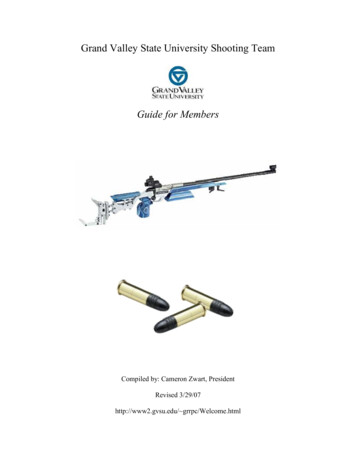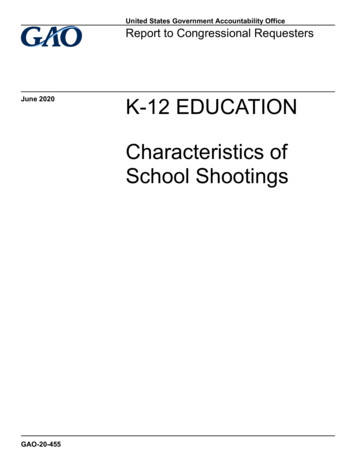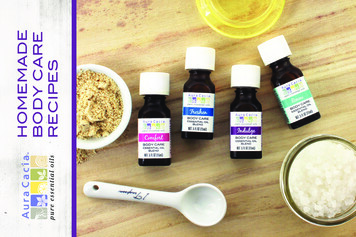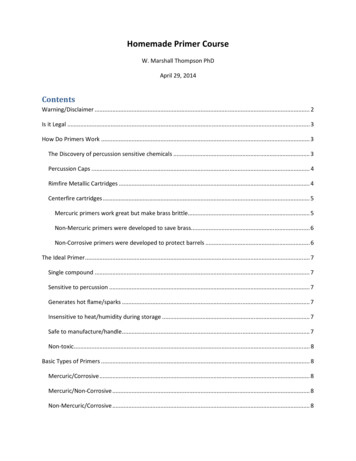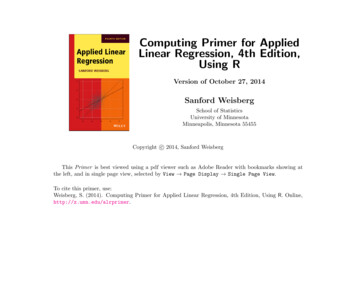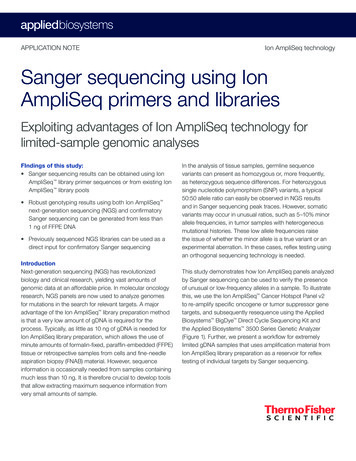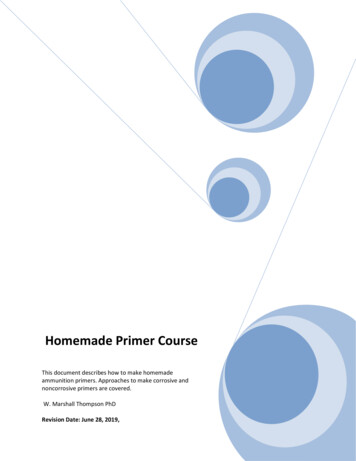
Transcription
Homemade Primer CourseThis document describes how to make homemadeammunition primers. Approaches to make corrosive andnoncorrosive primers are covered.W. Marshall Thompson PhDRevision Date: June 28, 2019,
ContentsWarning/Disclaimer . 4Is it Legal . 4How Do Primers Work . 4The Discovery of percussion sensitive chemicals . 4Percussion Caps . 5Rimfire Metallic Cartridges . 5Centerfire cartridges . 6Mercuric primers work great but make brass brittle. 7Non-Mercuric primers were developed to save brass. 7Non-Corrosive primers were developed to protect barrels . 7The Ideal Primer . 8Single compound . 8Sensitive to percussion . 8Generates hot flame/sparks . 8Insensitive to heat/humidity during storage . 8Safe to manufacture/handle . 9Non-toxic . 9Basic Types of Primers . 9Mercuric/Corrosive . 9Mercuric/Non-Corrosive . 10Non-Mercuric/Corrosive . 10Non-Mercuric/Non-Corrosive . 10Reliable Homemade Primers . 10Preparation of primer cups . 102
Primers made from toy caps . 11Primers made from strike-anywhere matches . 14Primers made from strike-on-the-box matches . 15Primers made with H-48 compound . 15Making Non-Mercuric/Non-Corrosive Primers . 18Primers made with Lead Nitratohypophosphite. . 18Primers made with Tetrazene. . 22Primers made with Styphnic Acid. . 23Primers made with Picric Acid. . 26Primers made with Lead Picrate / Lead Nitrate / Lead Acetate Clathrate. . 29Primers made with Lead Azide . 30Primers made with Copper Azide. . 32Making Non-Toxic (aka Green) Primers . 33Primers made with DDNP. . 34Primers made with Copper Azide/Strontium Nitrate/Zinc Peroxide. . 36Primers made with Bismuth Trioxide/Aluminum. . 36Appendix . 39References . 39Primer chemical suppliers . 40Primer formulations . 41Synthesis of primer chemicals . 46Revision History . 463
Warning/DisclaimerThis course discusses the creation and work with chemical compounds and mixtures that present a realrisk of serious injury and/or death if mishandled. In addition, some of the chemicals discussed are toxicand present a danger to a person’s health if inhaled or ingested. Primer compounds are considered tobe “Primary” explosives. This designation is a result of the sensitivity of these materials to percussion,heat, and sparks (both electrical and mechanical) and their intense power during detonation. Therefore,anyone who uses this information to make primer compounds or primers does so at their own risk. Thecreators and instructors of this course will not be held legally liable for any accidents or injuries resultingfrom this information.To avoid serious injury or death, always work with primer compounds in small quantities of less than 2grams ( 30 grains) at a time. Always wear eye protection and work in a clutter free, well-ventilated area.It is recommended that wood, plastic, or other non-sparking tools be used to avoid accidental ignition ofprimer compounds and primers. Work on a non-porous surface and carefully clean up all residue anddust from the work area when finished. It is important to wash your hands thoroughly with soap andwater after working with primer compounds to avoid accidental poisoning.Is it LegalAccording to current BATFE rules, making ammunition primers for your own personal use is legal (as ismaking your own fireworks.) Selling them or even giving them away is not legal without acquiring theappropriate Federal License(s) for manufacturing and selling explosives. Despite the absence of Federalrestrictions on personal primer manufacture, there may be state regulations that affect how you storecertain chemical compounds and in what quantities they may be stored. Consult competent legal adviceif you are unsure of your particular situation. Be aware that making primers in your home, garage, orexternal workshop is likely to carry more restrictions than making them in a commercially zonedbuilding.So, making primers on a small scale for your own personal use is unlikely to get you into trouble. Nonethe-less, expect your name to appear on some government list if you purchase several of the chemicalsneeded to make various primer mixtures. Finally, some very useful chemicals for making primers arelegally restricted by the government (e.g. Red Phosphorus) and cannot be legally purchased orpossessed by individuals who do not have the appropriate licenses or work for a company that has alegitimate need for those chemicals.How Do Primers WorkThe Discovery of percussion sensitive chemicalsIn the 1700’s and early 1800’s, a number of chemists made various compounds that were found to besensitive to shock, heat, friction, and sparks. While many of these compounds were extremely sensitive4
dangerous and unpredictable, others were more tame and although risky could be manipulated andused for various purposes such as military explosives. One such material was mercury fulminate whichwas easily synthesized from metallic mercury, alcohol and acid.In general, all percussion sensitive chemicals are ignited in the same way under a sharp blow. As thematerial is crushed, sharp edges on some of the primer ingredients rub against one another creatingfriction and very localized high temperatures. When these temperatures become high enough, thereaction of the primer mixture is initiated and rapidly spreads throughout the mass generating heat,flames and incandescent particles. There is a threshold of impact energy that must be crossed to ignite agiven primer mixture. This threshold energy is routinely measured by commercial primer manufacturerson every lot of primers they make to be sure they are neither too sensitive (e.g. round goes off whenaccidentally dropped on a hard surface) nor too insensitive to impact (e.g. misfires.)Percussion CapsDuring this same time, flintlocks were the state-of-the-art in firearms but suffered from unreliableignition, especially in rainy or damp conditions (recall the admonition to “keep your powder dry”.) Thesearch for a better ignition system eventually brought the shock sensitive compounds together withfirearms. Percussion caps were first made and patented in the early 1800’s and were widely used untilthe end of the Civil War. These caps were typically composed of a copper cup partially filled with amixture of mercury fulminate and several other chemical compounds. The caps were placed over anipple containing a hole that led to the powder charge inside the barrel. When struck by the gun’shammer, the primer compound exploded sending hot gases and sparks through the nipple to thepowder charge causing it to ignite. This invention greatly improved the ignition reliability of muzzleloading guns.Rimfire Metallic CartridgesSeveral decades after the development of percussion caps, a self-contained metallic cartridge wasdesigned that placed the primer compound into a deformable hollow rim. The 22 short was the first5
metallic cartridge introduced in the US (1857) and continues to be commercially available to this day.Other larger caliber (up to 56 caliber) rimfire cartridges were designed and used in the Civil War andwere commercially available until the early 1900’s. All of these larger caliber rimfire cartridges wereeventually replaced by the superior centerfire design due to the pressure limitation of the rimfire casing.The requirement to have a rim that was thin and soft enough to crush with the firing pin limited theinternal pressure that these casings could safely contain without failing.Centerfire cartridgesShortly after the Civil War, new cartridge designs were developed to make the production ofammunition more efficient. Eventually, the current centerfire cartridge design was developed that useda separate primer located in the center of the cartridge head. A major advantage of this design was thatthe cartridges could be easily reloaded by replacing the fired primer with a new one, refilling the casewith gunpowder, and pressing in a new bullet. Reloading tools quickly appeared allowing cowboys toreload their ammunition while sitting around the campfire in the evenings.6
Mercuric primers work great but make brass brittleThe same types of priming compounds originally used in percussion caps were still being used inthe new centerfire primers. It was discovered that the cartridge brass became brittle and tendedto crack when reloaded. This embrittlement was found to be caused by residues from themercury fulminate based primers. Metallic mercury formed during the combustion of mercuryfulminate selectively attacked and amalgamated the zinc in the brass alloy causing it to becomebrittle. Pure copper casings were briefly used to avoid this problem, however, copper was foundto be too soft to hold up well to the high pressures generated during firing. Therefore, topreserve the brass for reloading a new primer compound was needed that did not use mercuryfulminate. Despite the knowledge that mercury fulminate based primers ruined brass casings forreloading, non-corrosive mercuric primer formulations continued to be used in commercialammunition until the early 1940’s.Non-Mercuric primers were developed to save brassIn the late 1800s mixtures of potassium chlorate (KClO3) with various “fuels” were found to besuitable for use in primers. These mixtures were reliable and had a long storage life even underunfavorable conditions commonly encountered in military campaigns. The main negative aspectof these primers was their “corrosive” effects on steel barrels and receivers. This was especiallynoticed during the conversion from black powder to smokeless powder which occurred aroundthe same time. When black powder burns it produces a large quantity of soot and otherresidues that coat the inside of the gun barrel. This powder residue was found to create aprotective barrier to the corrosive effects of potassium chlorate primer residues. Whenammunition cartridges began using smokeless powders, they burned so cleanly that nosignificant residues were formed inside the barrel. Therefore, the corrosive primer residuescame into direct contact with the steel and rapidly caused pitting, rusting and corrosion. Sincesignificant corrosion could occur overnight it became necessary that guns be cleaned withinhours of being shot to avoid damage.Non-Corrosive primers were developed to protect barrelsIn the 1930’s new non-corrosive primer formulations were developed in Europe that eliminatedthe requirement to clean guns quickly after shooting them. The combustion residues are noncorrosive to steel and brass. Most of these new formulations are based on lead styphnate, anexplosive lead salt. More recently, some of the newer “green” primers have replaced leadstyphnate with safer chemicals that do not contain toxic heavy metals. Virtually all commerciallyavailable primers today use either lead styphnate and/or lead azide as the primary explosive.7
The Ideal PrimerCommercial primers are amazingly reliable devices with a failure rate of less than 1 in 3 million. It isinteresting that the most important step in primer manufacture, filling the cups with primer compound,continues to be done by hand. Despite this phenomenal performance, no “ideal” primer exists today.The ideal primer should perfectly meet all of the following requirements.Single compoundIt would great if a single pure chemical compound could be used in the primer. Unfortunately, nomaterial has yet been found that can perform all the required functions. Therefore, all modern primercompounds continue to be composed of physical mixtures of 3 or more compounds.Sensitive to percussionThis property is a fine line. The primer must be sensitive enough to be reliably set off by the firing pinstrike, but not so sensitive to be set off by normal manufacturing and handling processes. Ever noticethat accidentally dropped rounds almost never fire? This is why.Generates hot flame/sparksObviously the fired primer has to generate enough energy to ignite the propellant. This is relatively easywhen fast pistol powders are being ignited. Magnum pistol and most rifle powders are much slower toburn and harder to ignite. Also, some powders are susceptible to position variability when used at lowfill rates unless a suitably energetic primer is used.Insensitive to heat/humidity during storageAmmunition is often assembled and stockpiled for years before use. The primer must not quicklydegrade when the ammunition is stored in less than ideal conditions. Commercial primers are calculatedto last at least 150 years when stored under normal temperature/humidity conditions. I am personallyaware of ammunition made in the 1870s that has been shot in 2014 without any problems (i.e. no8
misfires or squibs.) Today’s primer compounds are even more stable to storage than the typical mercuryfulminate based primers made in the 1870s. The main exception for primer stability are some of thenew “green” primers. Some of these are known to have problems with a short storage life.Safe to manufacture/handleIn this case, safe is only a relative term as any primer formulation that is sensitive enough to use inammunition will inherently be risky to make and handle. It is hard to appreciate the tremendous amountof energy released by the tiny amounts of primer compound used in an ammunition primer. A teaspoonof primer compound is easily enough material to cause serious injuries, damage or a fatality should itunexpectedly explode. Commercial primer manufacturers know that even with the best possibleprecautions and safety procedures, an accident will occasionally occur during primer production. Thesecompanies manage this risk by using small batch sizes of primer compound (they typically work with 1-5lb batches) working in reinforced blast proof buildings and only allowing a few employees to work in thebuilding at a time. Despite these precautions fatalities still happen but are thankfully rare. Primers cantolerate a surprising amount of abuse when slowly deformed (i.e. staying below the threshold energy forignition.) However, an accidental stray spark of static electricity could easily cause an entire batch ofprimer compound or prepared primers to go off with disastrous results. There is a good reason whyspecial HazMat fees are charged to ship primers. In summary, no compound that is shock sensitiveenough to be successfully used in primers will be totally free of explosion risks during its manufacture orhandling.Non-toxicBecause of the use of lead styphnate and other heavy metal salts, modern commercial primers createvarious hazardous residues during combustion. This is normally not a problem when good ventilation ispresent and exposure is infrequent. However, workers at indoor shooting ranges can sometimes beexposed to enough lead in the air to cause health problems. This was the main reason for the creation of“green” (i.e. no heavy metals) primers. Interestingly, the non-mercuric but corrosive primer compoundsused in the late 1800s are much safer for your health since no heavy metal salts were used.Basic Types of PrimersThe primer compound is a mixture of materials performing one or more of the following functions: 1)initiator, 2) oxidizer, 3) fuel, 4) sensitizer, 5) frictionator, and 6) binders. There are 4 general classes ofprimer compounds, each with their own advantages and disadvantages.Mercuric/CorrosiveThis class represents the original compounds developed for percussion caps. These primers have a goodbalance of energy and sensitivity and are simple to make. The combustion residues are corrosive andrequire prompt cleaning of the gun after using it with these primers. As noted before, the use ofmercury fulminate made brass cases brittle so they could not be safely reloaded.9
Mercuric/Non-CorrosiveOnce the corrosive nature of the older mercury fulminate primer compounds was recognized, otherformulations were developed that while still using mercury fulminate, were no longer corrosive. Theseprimer compounds still ruined the brass cases for reloading, but they no longer corroded steel barrels.Primers using this type of compound continued to be available until the start of WW2.Non-Mercuric/CorrosiveIn the late 1800s, the US military decided they wanted to reload their fired casings to save money onammunition. A new primer compound that was non-mercuric was developed that did not harm thebrass, but was also found to be corrosive. These primer formulations are mostly based on potassiumchlorate mixtures. It was not until the early 1920s that the corrosive residue attacking the steel wasidentified as potassium chloride. The damage to the gun barrel can be easily prevented by washing outthe corrosive salts using hot water. This cleaning procedure was routinely used by all soldiers until about1950 when all military ammunition was converted to non-corrosive primers.Non-Mercuric/Non-CorrosiveAll modern commercial primers are of this class. Most of these primers are based on lead styphnate,although some use lead azide. Except for the new “green” primers, all of these primer mixtures generatetoxic heavy metal salts during combustion.Reliable Homemade PrimersOf all the techniques and methods available to make homemade primers, only three are consideredfeasible for the average non-chemistry trained reloader. Regrettably, all of these methods produceprimers of the non-mercuric/corrosive type and require the tried and true hot water cleanup proceduresto avoid damaging your barrel.Preparation of primer cupsIt is entirely possible to make your own primer cups from sheet brass if you are a machinist or are ableto have the special dies custom fabricated. The needed technical drawing for making these dies can befound in the “Making Ammunition” reference book noted in the appendix.It is more convenient to reuse previously fired primers (you have been saving them, right?). However,they must be properly cleaned and prepared for reuse. The steps below show my technique forpreparing the primers.1. Fill a rock tumbler drum about 1/3 full of used primers. Fill with water to about 2/3 full and adda squirt of dish detergent. Seal up the drum and tumble for about 30-60 minutes. Pour off thedirty water, rinse the primers and repeat the cleaning operation 2 more times. This will removevirtually all of the toxic lead salts from the primers and make them clean and shiny.10
2. Pour out the clean damp primers onto paper towels, spread them out into a single layer andallow them to drain and dry overnight.3. Next remove the anvils from the primers by holding the primer with a pair of needle nose pliersand using a sharp pointed awl or similar tool get under a leg of the anvil and pop it out. With alittle practice, you can do this quickly and easily without losing the tiny anvils. Remove any paperresidue (i.e. the foil) you may find that sometimes remains in the primer cup. Discard anyprimers that are excessively distorted or flattened. It has been my experience that large rifleprimers can rarely be reused due to excessive flattening.4. Using an appropriate sized flat punch or flattened nail, set the primer on an anvil or othersmooth metal block and punch out the firing pin dimple. It is rare for the firing pin dimple to becompletely removed during this operation since the metal can flow under the firing pin and beslightly thinner than the surrounding areas. Discard any primers that have an especially heavyprimer strike or are pierced.5. Store the prepared primer cups until ready for reloading.I recommend keeping SR and LR primers separate from SP and LP primers. This will avoid problemswith misfires in pistol cartridges due to the thicker primer cups used in rifle primers. Sometimes theywork and sometimes they don’t or require multiple strikes to get them to fire. The same issue wouldexist if you were to use new rifle primers in pistol cartridges. The firing pins in pistols are not able tostrike the primers as hard as a rifle does.Primers made from toy capsThis method is the easiest, safest and least likely to get you on a federal watch list. On the other hand,the resulting primers are not very energetic and may fail to reliably ignite some powders. The best toycaps to use are made in Germany and can be found under various brand names at Walmart or at DollarGeneral. The caps made in China are inferior for use in cap primers. Don’t waste your money buyingthem. Here are the steps for making cap primers:Materials needed: a) leather punch or handheld 1/8” paper hole punch, b) rolls of good quality caps, c)bamboo skewer, d) fast pistol powder1. Using a leather punch, cut out a number of cap blisters from the roll of caps to the appropriatesize to fit inside of the primer cups you are reloading. For SP primers, I have found that handheld paper hole punches that make 1/8” holes will work well. As much as possible, try to centerthe cap blister in the punched out circle. Expect to accidently set off a few caps while doing thisoperation. If you do pop off a cap or two, carefully wash the punch when you have finished withhot water or the punch will quickly start to rust from the corrosive cap residue (i.e. just like yourgun barrel.)11
2. Place one cap circle inside of a prepared primer cup with the blister facing up and carefully packit down with the end of a bamboo skewer.3. To give the primer a little more energy, sprinkle a thin single layer of fine gunpowder over thecap. Bullseye is an excellent choice, but any fine grained pistol powder will work. I have a cup ofscrap gunpowder I use for this purpose that was recovered from live rounds I occasionally find inthe brass box at the range.4. Place the second cap circle, blister side up, over the gunpowder and carefully pack it down withthe bamboo skewer.5. Finally, place a saved anvil over the cup pointy end down and carefully/slowly push it into placeusing the side of your needle nose pliers. Even being very careful, I typically pop off about 1 outof 20 primers during this operation. If that happens, disassemble the primer, clean the cup andreload with new caps and gunpowder. Once assembled, the primer is ready for immediate use.To avoid accidentally popping the caps, it is possible to desensitize them by lightly moisteningthem with 90% isopropyl alcohol before pressing in the anvil. After the alcohol and waterevaporates (at least several hours or leave overnight to be sure they are dry) the caps becomesensitive again and will work like normal.6. Save your completed primers in an empty primer box, or use them as normal in makingammunition. Any difficulties in getting the primers to seat properly can usually be traced to adistorted primer cup. The more discriminating you are when sorting out questionable primercups, the less likely you are to have any problems seating the reloaded primers. It is rare to havea cap primer pop during normal seating in a casing but it does occasionally happen. When madecorrectly these primers have excellent reliability. With good consistent assembly techniques,less than 1 out of 1000 cap primers will typically be expected fail. In most cases I have analyzed,the cap primer was found to have fired, but was not energetic enough to set off the gunpowder.These primers have successfully set off powders as slow as IMR 4895 used in 223 Remingtoncartridges.7. The cost of making cap primers is quite low ( 0.003/primer) compared to commercial primers( 0.04/primer), or about a 10:1 cost advantage.12
It is possible to make percussion caps using toy caps. A tool called a tap-o-cap was marketed by Forsterseveral years ago that can stamp out and make #11 percussion caps from aluminum drink cans.Although this tool is out of production, it can occasionally be found for sale on eBay.If you are handy in the machine shop, you can make a similar tool using these mechanical drawings:13
Primers made from strike-anywhere matchesThis method is easy, relatively safe and unlikely to get you on a federal watch list. In fact, this is themethod that the military teaches its troops for making improvised ammunition (see TM 31-210,Improvised Munitions Handbook.) The resulting primers are more energetic than cap primers, but stillsignificantly less than commercial primers. The main problem with this method is finding good strikeanywhere matches. The only part of the match that is used to make the primer is the white tip whichseems to have shrunk in recent years. The only ones readily available are from Diamond which are greenwith a small white tip. It takes 3-4 matches to make a single SP primer. Here are the steps for makingcap primers:Materials needed: a) Strike anywhere matches, b) razor blade or sharp knife, c) hammer (optional), d)bamboo skewer (optional),1. Working on a non-porous surface, carefully cut off the white tips of 3-4 matches using a razorblade or sharp knife. For safety and because it is so easy to set this compound off, only processenough matches at a time to make one primer. Only the white part is wanted, so be car
Homemade Primer Course This document describes how to make homemade . It is recommended that wood, plastic, or other non-sparking tools be used to avoid accidental ignition of
